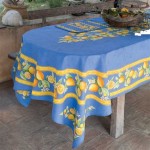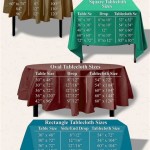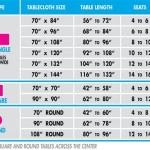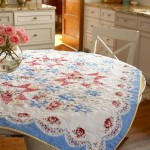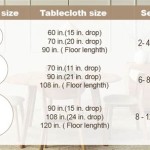What Can I Use Instead Of A Table Runner?
The table runner, a long, decorative strip of fabric laid across a table, has long been a staple in dining decor. However, its purpose, primarily aesthetic, can be achieved in numerous other ways. Circumstances such as a desire for a different style, a lack of suitable table runners, or the need for a more practical or easily maintained alternative might prompt the exploration of alternative table coverings and decorations. The following details several options that can effectively replace a traditional table runner, providing both visual appeal and functionality to a table setting.
Alternative Table Linens
One of the most direct replacements for a table runner involves the use of other types of linens. These alternatives offer various textures, patterns, and levels of coverage, enabling customization based on the occasion and desired aesthetic.
Tablecloths: A tablecloth provides full coverage of the table surface, offering protection against spills and scratches. They come in a wide array of materials, from cotton and linen to polyester and vinyl. Choosing a tablecloth with a pattern or texture can eliminate the need for a runner altogether. A white or neutral tablecloth provides a versatile base for a more minimalist approach, allowing other decorative elements to stand out. They can be paired with placemats for individual settings or used alone for a cleaner look. The choice of material influences the overall formality of the setting; for instance, linen conveys a more relaxed and rustic ambiance, while satin suggests a more formal and elegant occasion. Consider the size and shape of the table when selecting a tablecloth; it should drape evenly on all sides without touching the floor.
Placemats: Using placemats offers a more individualized approach compared to a table runner. Each diner has a designated space, which can be particularly useful for protecting the table from heat or spills. Placemats are available in diverse materials, including fabric, cork, bamboo, and plastic. Fabric placemats can be coordinated with the room's color scheme, while natural materials like cork or bamboo add a touch of organic texture. The shape of the placemats can also contribute to the overall design, with round placemats offering a softer contrast to rectangular tables. Combining placemats with a central centerpiece or decorative object can create a balanced and visually appealing table setting. This is a strong solution when highlighting the wood grain of the table.
Table Squares or Overlays: A table square or overlay is a smaller cloth placed on top of the main tablecloth. It functions similarly to a table runner in providing a decorative layer. These overlays can be used to introduce color, pattern, or texture without completely covering the entire table. They are often placed diagonally across the table for a more dynamic and visually interesting arrangement. Overlays can also be layered, using different colors and textures to create depth and dimension. Lace or embroidered overlays bring elegance and sophistication, while more casual materials like burlap or denim offer a rustic charm. The key is to ensure that the overlay complements the base tablecloth and the overall theme of the event.
Incorporating Natural Elements
Bringing elements from nature indoors provides a refreshing and organic alternative to a fabric-based table runner. These natural options are relatively inexpensive, easily sourced, and can add a unique visual texture to the table setting.
Garlands: Garlands composed of greenery, flowers, or even autumnal foliage can be arranged down the center of the table to create a visually striking runner alternative. Fresh greenery, such as eucalyptus or ivy, offers a pleasant aroma and a natural, calming aesthetic. Floral garlands can be customized to match the color scheme of the event or the season. For fall gatherings, garlands made of leaves, berries, and mini pumpkins create a festive and seasonal display. It is important to consider the maintenance requirements of fresh garlands, as they may require watering or misting to stay vibrant. Artificial garlands offer a longer-lasting and lower-maintenance option, but the quality of the materials should be carefully assessed to ensure a realistic appearance. The density and length of the garland can be adjusted to suit the size and shape of the table.
Branches: A collection of interesting branches, either arranged simply or incorporated with other decorative elements, can serve as a striking focal point on a table. Branches can be sourced from the outdoors or purchased from floral supply stores. They can be displayed in their natural state or painted to match the room's decor. For a more dramatic effect, tall branches can be placed in vases to create height and visual interest. Smaller branches can be laid horizontally down the center of the table, creating a more subtle and understated runner alternative. Consider the shape and texture of the branches when choosing them; gnarled or twisted branches add character, while smooth, straight branches offer a more modern and minimalist look. Branches can also be adorned with lights, ornaments, or other decorative items to enhance their visual appeal.
Fruit and Vegetable Displays: A visually appealing arrangement of fruits and vegetables can serve as both decoration and a conversation starter. This option is particularly suitable for casual gatherings or for tables that need to be both functional and aesthetically pleasing. Arrange a variety of colorful fruits, such as apples, oranges, lemons, and grapes, down the center of the table. Alternatively, create a display using seasonal vegetables like pumpkins, gourds, or artichokes. The arrangement can be formal or informal, depending on the desired aesthetic. For a more rustic look, use wooden crates or baskets to display the fruits and vegetables. Consider the color and texture of the produce when creating the arrangement; contrasting colors and varying shapes add visual interest. This option is not only visually appealing but also encourages healthy snacking.
Decorative Objects and Arrangements
Beyond linens and natural elements, a wide range of decorative objects can be used to create a visually appealing and functional table setting, effectively replacing the role of a traditional table runner.
Candles and Candleholders: A collection of candles in varying heights and styles can create a warm and inviting ambiance. Candles can be arranged down the center of the table in a linear fashion, mimicking the look of a table runner. Alternatively, they can be grouped together in clusters or placed in candleholders of different materials and designs. Tall candlesticks add height and elegance, while shorter votives create a more intimate atmosphere. Consider the type of wax used; beeswax candles offer a natural scent, while scented candles can add a fragrance to the room. Be mindful of safety considerations when using candles; ensure that they are placed away from flammable materials and are not left unattended. Battery-operated candles offer a safer alternative while still providing the ambiance of real candles. The choice of candle color and style should complement the overall theme of the event.
Trays and Platters: A decorative tray or platter can be used to create a focal point on the table. These can be made of various materials, such as wood, metal, or glass, and can be used to display a variety of items, such as candles, flowers, or decorative objects. A long, narrow tray can mimic the look of a table runner, while a larger, round platter can create a more centralized display. Consider the size and shape of the tray or platter when choosing it; it should be proportional to the size of the table and the items being displayed. The material and design of the tray or platter should complement the overall style of the room. A wooden tray adds warmth and texture, while a metal tray offers a more modern and industrial look. Glass platters provide a clear and elegant base for displaying decorative items.
Books: Stacking books along the center of the table can create an intellectual and visually interesting display, particularly appropriate for a study or library dining area. Select books with attractive covers or spines that complement the room's color scheme. Arrange the books in varying heights and orientations to add visual interest. The books can be stacked horizontally or vertically, or a combination of both. Consider the subject matter of the books; displaying books on history, art, or literature can add a touch of sophistication. The books can also be adorned with decorative objects, such as small sculptures, candles, or flowers. This option is not only visually appealing but also provides guests with reading material during the meal. Ensure that the books are clean and in good condition before displaying them. Using books to decorate table creates an interesting display and adds a personal element to the room.

7 Alternative Table Runners

20 Alternative Table Runners

Smocked Table Runner Country Design Style
:max_bytes(150000):strip_icc()/simple-boho-tablescape-thanksgiving-fef7869ca92e43b2a865f2c734a074e4.jpeg?strip=all)
34 Table Runner Ideas For Any Style Or Occasion
:max_bytes(150000):strip_icc()/047_websize-1-1030x687-62522fe4a9db471090a419dbaf7e2a29.jpg?strip=all)
34 Table Runner Ideas For Any Style Or Occasion

Smocked Table Runner Country Design Style

10 Party Tablecloth Alternatives The Daily Hostess
:max_bytes(150000):strip_icc()/KMIMay2023_0131-9ae734d3993544dc8f3a4818b0396348.jpeg?strip=all)
34 Table Runner Ideas For Any Style Or Occasion

How To Set A Beautiful Table For Any Season Affordable Tablecloth Sources Sanctuary Home Decor
:max_bytes(150000):strip_icc()/DSC04242-1030x686-ea1030729d4b4b579121c9b06ed574ba.jpg?strip=all)
34 Table Runner Ideas For Any Style Or Occasion
Related Posts


